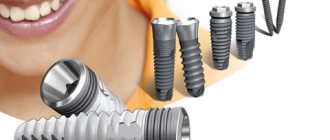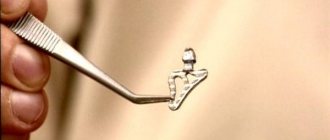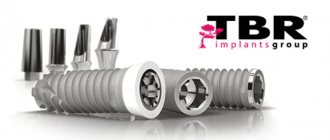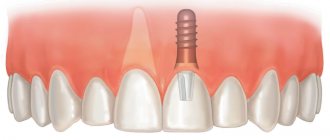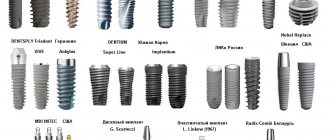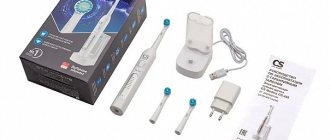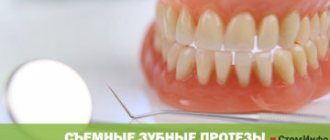What are combined implants - types, advantages and disadvantages, what can be replaced
Article navigation
- History of combined implants
- Varieties
- — plate-root-shaped dental implant
- - disc implants
- — Ramus-frame models
- — transosseous structures (transmandibular)
- Advantages
- What is known about the shortcomings
- – traumatism of mucous membranes and bone tissue
- – problematic bone survival
- – inability to use in narrow areas
- Indications and contraindications
- What is combined implantation
- Service life and guarantees
- Which implants are better – combined or classic?
- What alternatives are there?
- Price
Question for a specialist
Modern dental implants come in a wide variety of shapes and sizes. They are used to solve any clinical cases. In addition to standard root-shaped implants, there are also various combinations of shapes. Such designs are called “combined dental implants”, the types of which are presented in a fairly wide variety. But whether they are relevant in modern conditions – we will tell you in further material.
Types of systems
Modern maxillofacial surgery has various directions and types of implants. Their selection depends on the defects and individual characteristics of the patient’s oral cavity and jaw.
Before deciding which implant to install, the doctor carefully examines the volume of bone tissue in the patient.
Lamellar-root-shaped
The name of the modification aptly reflects the peculiarity of its design. The complex shape of the product consists of a plate, as in the plate design, and a cylinder, as in the root form. There is a screw in the middle.
Intraosseous products are not used very often. Mainly when the patient has a narrow jawbone or when bone tissue needs to be built up.
Technically, models are the most complex and expensive type. Therefore, it is used when other options are no longer suitable for the patient.
The implantation of lamellar-root-shaped implants, as well as subsequent prosthetics, can take about six months.
Disk
Combined products include disc implants. They are very quickly implanted into the bone structure.
The advantage of the systems is:
- the ability to install on any fragment of the jaw;
- prosthetics can begin 5 days after installation of the disc implant;
- heals quickly;
- low traumatic.
Implantation takes place through simple surgery.
Ramus-Frame
The endosseous implant has a noticeable external difference. A thin, branched plate fits into the jawbone in three areas. It is the basis for the prosthesis.
Such models replace the insufficient part of the bone tissue, which is why they perfectly perform the function of support.
Ramus-Frame is suitable in cases where dental prosthetics goes beyond the standard scope, that is, the patient has serious defects of the jaw bone or other problems that are difficult to eliminate.
Transosseous
The technique is applicable only for restoring teeth in the lower jaw. The collapsible design consists of an arched bracket, which is installed on the lower jaw arch through the chin.
The implantation technique takes place in stages:
- the soft tissue of the chin area is surgically peeled off, holes are made in the bone through which a staple is installed;
- Pins are implanted into the bone and connected to a curved support. Temporary prostheses are installed on them;
- After a certain time, a permanent prosthesis is installed.
The recovery period after transosseous surgery is quite long. Complete engraftment takes from 3 to 6 months.
This technique is prescribed when it is impossible to do without extraoral surgery.
History of combined implants
In the process of development of dental implantology and in attempts to create a model of a dental implant that is perfect in every respect, dentists have developed many different forms. For example, combined varieties were introduced that looked more like parts of some mechanisms than tooth roots.
These models had complex shapes (and even now they can cause understandable confusion in many patients). But, nevertheless, their use in the past was considered quite justified, since combined implants were developed specifically for patients with complex clinical situations.
Types of combined dental implants
Lamellar-root-shaped dental implant
Hybrid combinations consisting of a vertical cylinder to which plates are attached in various versions. In one of the varieties, the model is a horizontal plate fixed at the bottom of a thin vertical cylinder. And on the very top of this model there is a pre-installed abutment for fixing the prosthesis. In the second variation, “blades” with round holes are located on the sides of the cylindrical central part.
Simpl Swiss implant (Switzerland) + metal-ceramic crown = 35,000 rub.
All manipulations are included, treatment guaranteed!
Save RUB 15,000. for implantation >> Free consultation with an implantologist +7 (495) 215-52-31 or write to us
Disc implants
Disc combined models are structures also consisting of a thin vertical cylinder (with or without threads), and in the lower part they have a flat and wide disc base, which is fixed in the dense layer of the jaw bone (basal).
Ramus-frame models
Combined dental implants Ramus-frame (translated as “branched frame”) are an extended one-piece structure, at the bottom of which there are three implants at once. Moreover, one is fixed in the central section of the bone, and the outermost ones are fixed in the lateral areas where the chewing teeth were. The upper parts of all three implants are united by a metal arch that follows the dental arch. And this arched part remains above the gum - the prosthesis is placed on it. Ramus-frame models were developed for use in cases of severe bone atrophy, when its width and height are only 3 and 6 mm, respectively. Suitable for complete edentia (when there is not a single tooth in a row), mainly on the lower jaw.
Transosseous structures (transmandibular)
Transmandibular implants (translated as “passing through the lower jaw”) were developed for clinically complex cases. In particular, with an acute lack of bone tissue in the lower jaw and the inability to build it up. Transosseous can also be called a whole implantation system consisting of two cylinders and two arches.
Such implants are fixed not through the oral cavity, but through holes in the chin. First, an arch is installed in the lower part of the chin bone, and implants are inserted through it - which pass through the entire jaw, and their tops rise above the gum. And already in the oral cavity, a second arch is fixed to these tops, onto which the prosthesis is attached. The model is suitable only for the lower jaw and only in cases of complete absence of teeth.
Difficult choice in the dentist's office: partial dentures or implant-supported dentures?
Often, patients in dental clinics who need dental prosthetics are faced with a choice: what is better – partial removable dentures or partial dentures on implants?
Some argue that installing implants is a long, expensive and painful procedure, and that removable dentures are much more reliable.
Others say that only the installation of implants will allow normal restoration of the dentition.
To find out the advantages and disadvantages of implantation and removable clasp dentures, let’s consider what these two methods are.
What is a dental implant?
This is a device fixed into the bone tissue of the jaw and replaces a fallen or initially missing tooth. Dental implants support crowns, bridges of various lengths, removable and fixed dentures.
Several types of implants are used in dentistry, but the most widespread are root-shaped implants.
These are structures consisting of a metal rod implanted into the jaw tissue and an abutment - an artificial tooth that is ground into a crown.
If necessary, a gum former is installed on the implant shaft - a special metal screw with a cap. It is attached to the implant before installing the abutment and forms the gum relief to achieve an aesthetic result.
Root-shaped implants are cylindrical and screw with thread. The latter are more common, since due to the thread, the implant fuses more firmly with the jaw tissue.
What are implants made of?
Commercially pure titanium is most often used for the production of implants. A distinctive feature of this high-strength material is its ability to take root without problems.
The titanium rod of the implant is not rejected by the body, since it is not perceived by it as a foreign body. The only contraindication for use is individual intolerance to titanium.
In this case, implants are made from other materials.
Sometimes implants are made of zirconium dioxide. The advantage is that dioxide implants do not show through the gum mucosa, which sometimes happens with titanium ones.
But the main disadvantage of zirconium dioxide is the poor adherence of implants to jaw tissue and the difficulty of subsequent processing of the implant rod, therefore implants made from it are not often used in dentistry.
Implant shape
Observations show that the best shape is for implants made in the form of a threaded cone. This design allows you to change the angle of the implant during installation, which helps position the crown in a natural way.
The shape of the upper (coronal) part of the implant, otherwise called the neck, also plays an important role. The best option is an implant neck with grooves, shaped like an inverted cone. The bone tissue around such an implant will quickly grow, giving the tooth a natural appearance.
Survival and service life of implants
The healing time of implants is: on the upper jaw – from 6 months, on the lower jaw – from 3 months. Much here depends on the age of the patient, the quality of his bone tissue and the experience of the doctor installing the implants. But, if the implant is successfully implanted, it is almost impossible to remove it from the jaw.
A well-established implant will serve you for at least thirty years. If you follow your doctor's recommendations, the implant will last a lifetime. This refers to the part of the implant that is placed into the gum, the plate and abutment. The crown placed on the implant will have to be replaced, but it will last 10-15, or even 20 years.
Advantages and disadvantages of implants
If no contraindications are identified, then dentists advocate implantation. The only people against implants are doctors who do not have sufficient qualifications to perform such operations and recommend the installation of a removable prosthesis in their own interests, and not in the interests of the patient.
After all, the undeniable advantages of implantation are the restoration of the functions of a lost tooth, the prevention of deformation of bone tissue and facial features, and the absence of the need to grind adjacent teeth.
For many, the rather high price can be an obstacle to installing implants. But implantation pays off in the future, because as stated above, I install implants for almost my entire life.
Contraindications for implant installation
- General contraindications include diseases such as diabetes, AIDS, hypertension, cancer, bleeding disorders, diseases of the nervous and immune systems, and bone tissue.
- Implants are not placed on children and adolescents because during the growth period the implants become loose and can be rejected by the body. In addition, installed implants can lead to slower growth of individual organs.
- Implants are not installed during pregnancy and lactation.
- Specific contraindications for installing implants include the proximity of the maxillary sinuses, or sinuses. The width and density of the bone tissue of the upper jaw is also of great importance, especially at the point of contact with the sinuses. If it is insufficient, sinusplasty will have to be performed before installing implants.
- The installation of implants is contraindicated in case of chronic diseases, especially diseases of the oral cavity, as well as if the patient does not comply with the rules of personal hygiene.
- If the patient has insufficient height and bone density in both the lower and upper jaws, it is necessary to undergo bone grafting before installing implants.
Implant rejection
If in the first days after implantation you began to experience severe, unstoppable bleeding, the gums around the implant became very swollen and inflamed, and there was acute pain that did not go away even with painkillers, then you may have experienced implant rejection. You need to see a doctor urgently. At the same time, the norm is swelling, bleeding of the gums and aching pain during the first two to three days after implantation. If these symptoms last longer, then this may also be a sign of implant rejection.
In addition, sometimes implant rejection occurs without any symptoms. If, in the subsequent period after installation of the implant, inflammation, swelling, or pain appear around it, these may be signs of infection. If measures are not taken in time, the jaw bone will become inflamed, which will also lead to the loss of the implant.
Nowadays, the survival rate of implants is 95-97%. However, the dentist should warn patients about the possibility of implant failure. He still has to study the patient's medical record to find out if he has any contraindications to installing the implant. Such contraindications most often become the cause of rejection.
Refusal of postoperative and preventive medical supervision, heavy load on the implant in the first days after installation, smoking and poor oral hygiene also cause implant rejection.
Disadvantages of the implantation method
We found that the implantation method has virtually no disadvantages, except for contraindications in some patients. The only drawback is the high cost of implants.
Clasp dentures
Modern dentistry offers one of the most convenient types of dentures – clasp dentures. Such designs of prostheses differ from plastic and nylon ones in that they have a metal arch at the base. This arch (in German – “bugel”) gave the name to the prosthesis.
A layer of acrylic composition is applied to the metal frame of the clasp denture, onto which artificial teeth are mounted. This frame evenly distributes the load of the prosthesis on the gums and teeth. When using it, the sky remains open. Thanks to their metal construction, these dentures are much lighter and more comfortable to wear than acrylic dentures.
The service life of clasp dentures is at least 10 years. Clasp dentures are installed in the absence of two or more teeth in the upper and lower jaw. Both your own teeth and crown teeth can be used as supporting teeth for the prosthesis. Dentures can be installed even if you have a minimum number of teeth left.
Clasp dentures differ in the type of fastening. There are fastenings using clasps, attachments, splinting, and telescopic. The type of prosthesis fixation is selected individually for each patient.
Clasp fastening of the prosthesis is a common and economical option. To fix the prosthesis on the supporting teeth, metal arches - clasps - are used. The disadvantage is that they are visible when you smile. With clasp fastening of the prosthesis, 1/3 of the load falls on the teeth, 2/3 on the gums.
Attaching the prosthesis to attachments is an expensive option. In this case, the prosthesis is rigidly fixed in the mouth with special clasps and attachments. One part of the lock is on the prosthesis, the other is attached to the supporting tooth.
The disadvantage of this method of fixing the prosthesis is that the abutment tooth has to be ground down for the attachment. Advantage: the attachment of the prosthesis is not visible when smiling.
In addition, the load of the prosthesis on the teeth and gums is distributed equally, which is also an advantage of this type of fixation.
An aesthetic type of prosthesis fixation is a telescopic mount. In this case, the supporting teeth of the prosthesis are also ground, coated with a metal compound and polished. This is a complex high-tech process, since fixation is possible only if the fastening and the ground tooth are completely identical. The cost of a prosthesis with a telescopic mount is high, but the prosthesis itself is invisible in the mouth.
Conclusion
The implantation method is the most modern method of prosthetics; it does not require grinding of healthy teeth; implants replace lost teeth. But this method has many contraindications, and there is a danger of implant rejection. In addition, implant placement is an expensive procedure that is unaffordable for some patients.
Disadvantages of clasp dentures:
- removable dentures cannot be worn constantly without being removed;
- fixing the prosthesis on clasps is visible when you smile, while other methods require grinding of the teeth;
- You need to get used to dentures, so at first you will have to endure some inconveniences.
If a patient decides what is better – installing implants or a clasp prosthesis, then, first of all, he should listen to the doctor’s advice and evaluate his own financial capabilities, and then make a choice in favor of one method or another.
Source: https://www.LiderStom.ru/articles/protezirovanie-zubov/slozhnyy-vybor-v-kabinete-stomatologa-byugelnye-semnye-protezy-ili-protez-na-implantantakh/
What is known about the disadvantages, which are much more numerous than the advantages?
Disadvantage No. 1 – traumatism of mucous membranes and bone tissue
The main disadvantage is increased traumatism during the surgical stage. After all, in order to install a disk or plate implant, you have to cut out a piece of bone from the side of the dentition (and not drill a small hole at the top, as is done for classic models). After installation, the bone is returned to its place and fixed, but healing takes a long time and complications often occur[1]. And the installation of transosseous implants is associated with the risk of damage to the mandibular nerve.
“Back when I was at school, my mother decided to get an implant instead of a golden bridge, and went to our main regional city. There they installed some kind of thing for her that didn’t look like a tooth root at all. Rather, there is more of an association with an inverted key. So, after implantation, my mother had to recover for a very long time, because healing was generally bad. She constantly went to that dentistry for some procedures. In general, then she regretted a hundred times that she had refused the “bridge”.
Dmitry B., review on otzovik.com
Disadvantage No. 2 – problematic bone survival
Another significant drawback is the poor engraftment of such structures and subsequent rejection up to the removal of the implant. Indeed, in those days when combined models were just being developed, their diverse research was not given as much attention as is customary now. Also, combined models do not have surfaces with active properties that accelerate osseointegration.
All implantation systems being implemented must be tested for metal fatigue, susceptibility to loads, and the rate of osseointegration (fusion of the implant surface with the bone). Moreover, many manufacturers now continue research work on monitoring installed implants, closely collaborating with practicing implantologists.
Disadvantage No. 3 – inability to use in narrow areas
If, for example, the lower front tooth is missing, then placing a massive combined implant is very problematic. Firstly, this is often simply impossible to do. And secondly, during the installation process the roots of neighboring teeth may be affected.
Benefits of implantation
The operation to restore teeth using implants involves the introduction of an element resembling a tooth root into the bone tissue.
This procedure has many advantages over other methods of dental restoration.
One of the advantages of implantation is the correction of both the entire row and individual teeth.
According to dentists, the main advantages of implantation are the following:
- Elimination of various dental defects without causing harm to neighboring teeth. To install an artificial tooth, there is no need to remove nerves, grind the teeth or fill them. In addition, after fixing the crown, the implant begins to exert pressure on the jaw, taking on part of the chewing load, which has a beneficial effect on the condition of other teeth
- The ability to restore the dentition either completely or partially. Implantation allows you to replace an unlimited number of natural teeth with artificial ones. If there are indications for the installation of several teeth, there will be no need to screw many screws into the jaw
- Prevention of bone tissue atrophy. After tooth loss, the jaw gradually atrophies, but thanks to the introduction of an implant, the process of bone tissue resorption stops
- Reliable fixation. The structure is firmly fixed, after which the implant fuses with the bone tissue. Within two months after implantation, it is impossible to remove the product without surgery, which means there is no point in worrying about the installed element falling out.
- Aesthetic appearance. After installing the structure, the dentition looks natural and attractive, since the color of the crown is matched to the shade of the patient’s tooth enamel. Only an experienced dentist can distinguish artificial material from real teeth.
- Reinstallation of individual elements. If the first implantation procedure was unsuccessful or the implant was damaged due to serious injury, a new one can be installed in its place.
- Ability to bite and chew food. At the end of the rehabilitation period, the patient can safely eat his usual foods, including solid and tough foods
- Simple hygienic care. For high-quality oral care after tissue healing, it is necessary to brush your teeth twice a day, use rinses and dental floss - these are familiar and simple procedures that are usually performed with healthy teeth
- Long service life. If implanted correctly, the implant becomes part of the jaw, forever merging with the bone. No need to change or adjust it
Indications and contraindications
Indications for the installation of combined systems are indeed very complex clinical situations, when, for example, the patient has lost a lot of teeth and bone substance of the jaw due to an accident or illness, there is destruction of the bone and jaw and they have to be pieced together, including at the expense of implants. Here, combined implants can really help restore the dental system.
However, often in such situations, it is simply not standard combined models that are required, but those made according to individual parameters. Such products, for example, are produced by the Russian company. You will have to wait several weeks for their production, and there will be no indefinite guarantee here, because... It is not possible to fully subject an individual model to all quality checks.
Read on the topic: indications and contraindications for dental implantation - a complete list of dos and don’ts for restoring teeth using the modern method.
Contraindications to the installation of combined systems are the patient’s unsatisfactory health condition (serious pathologies of the heart and blood vessels, diabetes mellitus, etc.). This also includes children under 18 years of age, pregnancy and lactation, intolerance to anesthesia, and the inability to maintain oral hygiene after implantation.
What features do implants have?
Implantation involves installing a special titanium pin (artificial root) into the bone tissue in place of a missing tooth. The implant is the basis for the subsequent manufacture of crowns, bridge structures, and various prostheses.
Over a period of 3 to 6 months, the implants take root (fuse with the surrounding tissues). The implant itself is located under the gum and is not visible. A special transitional part (abutment) and an artificial tooth crown “stick out” from the outside, which is made only after the implant has healed.
This treatment method is effective; implants usually last for several decades. If you follow your doctor's recommendations, the implant can last a lifetime.
Advantages of this type of treatment:
- reliability and longevity;
- adjacent healthy teeth are not ground down;
- after tooth loss, implantation helps to avoid bone tissue deformation and facial features;
- Fixed crowns can be made for implants;
- The function of the tooth is restored completely and allows you to lead a full life.
Like any procedure, implantation has its drawbacks. There are a number of contraindications that make implantation impossible.
Some patients are not satisfied with the fact that before making crowns for implants, it is necessary to wait for their implantation (3-6 months).
Another feature of this procedure is its high cost. It is due to expensive materials, the need to use special tools, and the technical complexity of the installation. Sometimes, installing an implant requires bone tissue augmentation, which further increases the cost and duration of treatment.
What is combined implantation
Often, when the word “combined” is present in a phrase, confusion arises - what is it about? About implants or about implantation? So, understanding this difference is really very important. Combined implants have already been discussed above, now it’s time to briefly dwell on combined implantation.
Combined implantation does not necessarily involve the use of combined implants. Although the installation of transosseous or Ramus-frame can be called combined precisely because of the features of these models. In general, combined implantation can mean the following options:
- simultaneous combination of different models of implants: when the patient is given classic root-shaped implants in the “good” areas of the jaw bone, and elongated modifications are placed in atrophied areas. For example, this may well include the basal complex or zygomatic implantation, when zygomatic models are added to the classic protocols on four or six implants if there is little bone in the lateral zone,
- mini-implantation for the period of engraftment of classical root-like systems: mini-models here are immediately loaded with a prosthesis (so that a person does not walk without teeth), while the classic ones remain undisturbed in the bone for 4-6 months.
Which implants are better – combined or classic?
Analyzing all of the above disadvantages, patient complaints and negative reviews from implantologists, most development companies decided to abandon the production of combined implants due to low efficiency.
From the point of view of installation to the patient, behavior in the jaw bone and survival, implants that replicate the shape of a living tooth root or are close to them turned out to be optimal. Those. not combined, but classic - cone-shaped and cylindrical. They remained in mass production.
What alternatives are there?
Combined dental implants are mainly used for the most complex cases, but quite rarely. Because today, even in difficult situations, the patient and doctor have the opportunity to choose classic implants, installing them after preliminary preparation of the jaw bone structure. And for the most complex cases, modern basal implants from Oneway Biomed or zygomatic models from Nobel are suitable, which do not require bone augmentation and are installed using the “puncture” method (i.e. without incisions) using surgical, individually created templates.
Conditionally removable prosthetics
As a rule, conditionally removable dentures are used when it is necessary to correct single defects of molars. Their advantages include the possibility of easy removal and replacement with any other prosthesis, no need to follow special care recommendations, and high aesthetics. Conditionally removable dentures are attached to the implants with screws, and the holes above them are filled. This method of prosthetics allows, if necessary, to thoroughly clean the prosthesis and monitor the condition of the implant heads at an appointment with a dentist. To do this, simply remove the seals and unscrew the screws.
Cost of combined systems
The price of combined dental implants ranges from 5-15 thousand rubles per piece. But for diagnostics, preparatory stages, the work of an implantologist and orthopedist, as well as for the prosthesis, you will have to pay an additional 20-30 thousand rubles or more (if you need, for example, a prosthesis for the entire jaw, then it will cost at least 100 thousand rubles).
[1] Bregger U., Hetz-Mayfield L., Biological and technical complications of implant treatment, 2020.
Author: Zhilenko E. A. (Thank you for your help in writing the article and the information provided)
The work was completed by:
- Tsukor S.V. – orthopedic dentist, chief physician of “Dial-Dent” – diagnostics, dental prosthetics, general treatment planning;
- Matienko T.I. – dentist-endodontist – treatment of tooth canals with a microscope;
- Yakimenko I.I. – periodontist surgeon – tooth extraction, gum treatment with laser;
- Volk D.V. – dental technician – production of bridge dentures, production of clasp dentures with locks.
- Smirnova E.P. – consultation and selection of products for hygienic care of removable dentures.
The cost of bridge dentures is 11,900 rubles, a clasp denture is 80,000 rubles, dental canal treatment with a microscope is 20,000 rubles.
See other works of Dial-Dent specialists here.
